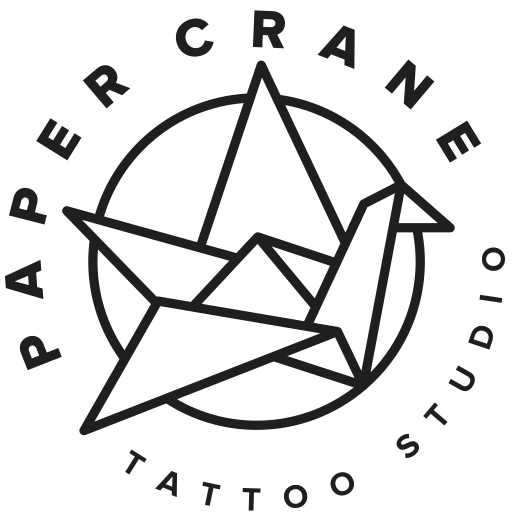Tattoo Style Check: From Traditional to Trash Polka

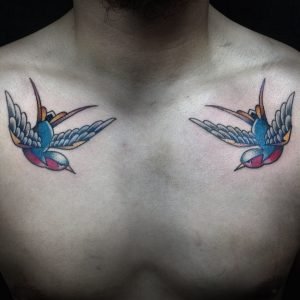
(Tattoo by Tan Vo)
Neo-Traditional Tattoos: As the name implies, neo-traditional tattoos evolved from the traditional style. Like their predecessors, these tattoos typically feature vibrant colors and bold lines. But neo-traditional uses a wider range of both colors and line weights, which gives tattoos more depth, detail, and realism. Popular subjects include traditional imagery with a unique spin as well as animals and scenes from nature.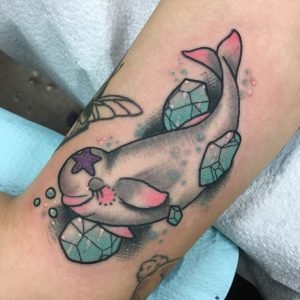
(Tattoo by Chelsea Jane)
Illustrative Tattoos: Illustrative tattoos are also rooted in the traditional aesthetic, and they have a lot of similarities to neo-traditional tattoos in that they feature an expanded color palette, variety of line weights, and more realistic shading. But whereas neo-traditional tattoos typically still have the look and feel of American traditional tattoos, illustrative pieces resemble an actual illustration. For some artists this includes linework that looks like pencil or brush strokes, whereas others let the depth of shading and range of color gradations lend a tattoo that particular quality. The sky is the limit as far as subject matter goes. (Don't worry if you can't tell if a tattoo is neo-traditional or illustrative: It can often be a subtle difference, and sometimes the answer would depend on who you asked.)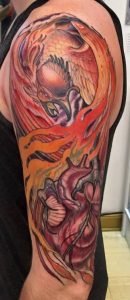
(Tattoo by Justin Tauch)
Watercolor Tattoos: Becoming increasingly more popular with every social media post you see, watercolor or painterly tattoos often look more like something you'd see on your wall than on a human canvas. These tattoos imitate brushstrokes to varying degrees: Some may have bold strokes or paint “splatters,” whereas others have a softer, more blended look. They tend to feature a softer color palette, often incorporating pastels or subtle color variations. Watercolor tattoos can have zero black lines for an almost ethereal look, but there is some concern that a lack of darker linework might cause such tattoos to lose shape over the years, so some artists prefer to incorporate a base or framework to hold the colors in place. As with illustrative tattoos, the watercolor style is used for a variety of images, with some of the more popular choices including fish and flowers.

(Tattoo by Mikey Vigilante)
Blackwork Tattoos: On the opposite end of the spectrum from watercolor is blackwork. Whereas black-and-grey tattoos feature shades of both black and grey (using either watered-down black ink or prefabricated grey ink), blackwork tattoos have zero shading. Sacred geometry, bold patterns, and large swaths of solid black typically characterize blackwork pieces, but this style can also include extremely detailed subjects that have an illustrative quality to them.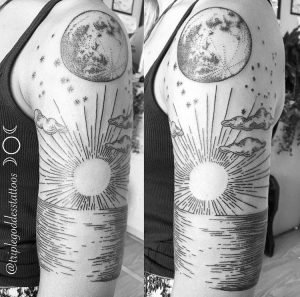
(Tattoo by Joy Shannon)
Dotwork Tattoos: As you might have guessed, dotwork tattoos consist solely of dots—lots and lots of dots, depending on the piece! Dotwork tattoos require the artist to precisely place tens, hundreds, or perhaps even thousands of dots into a pattern to achieve the desired image, whether that's a sacred symbol or a portrait of an animal. These tattoos typically are done in shades of black or red, and the end product can be a simple design or have an almost three-dimensional look to it. Dotwork can be incorporated into other tattoo styles such as blackwork to give a piece depth without resorting to color variation.

(Tattoo by Mikey Vigilante)
Realistic Tattoos: Like watercolor tattoos, realism is extremely popular in the current era, whether you're interested in black-and-grey or full color. Realistic tattoos implement expert linework and shading to create a style that is extremely true to life—almost like looking at a photograph, which is why you might hear it called photorealism. Meticulous planning and attention to detail can make a photorealistic rose look like you could actually pick it off of someone's arm or a butterfly look like it might fly away at any second. Unfortunately, a lack of expertise can make realistic tattoos some of the biggest disasters in the industry, as evidenced by the many examples of horrific portrait tattoos. We always encourage you to scrutinize any artist's portfolio, but that goes double for realistic pieces!
(Tattoo by Adrian Franco)
Irezumi Tattoos: Irezumi is the proper term for traditional Japanese tattoos. Originating in Japan in the 1600s, this style still focuses on classic themes from folklore, legend, and history: Dragons, samurai, phoenixes, geishas, cherry blossoms, koi fish, kitsunes, kappas, and other subjects both mythical and mundane serve as common subject matter. Although you can get an Irezumi-style tattoo anywhere you choose to, the traditional bodysuit covers the arms, back, upper legs, and chest (leaving an untouched channel down the center of the body).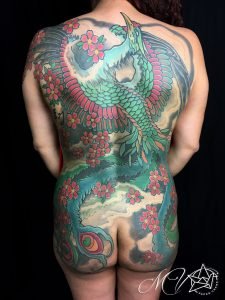
(Tattoo by Mikey Vigilante)
New School: Originating in the 1970s, new school tattooing evolved from the traditional (or old school) style. You can see new school's old school roots in the bold lines and heavily saturated colors. But new school incorporates exaggerated or cartoonish elements not typically found in traditional tattoos. Bobble-headed characters from your favorite Disney movie or outlandishly dressed animals in unlikely situations are some of the common images associated with this style.Trash Polka: Created at Buena Vista Tattoo Club by Simone Plaff and Volko Merschky in Würaburg, Germany, Trash Polka has a collage-like quality that incorporates both realistic and abstract imagery in a fine-art style. Random bits of lettering, detailed silhouettes, geometric patterns, and smudges of ink characterize Trash Polka tattoos, which are done exclusively in back and/or red ink. Trash Polka is full of chaos and movement, with an extremely unique aesthetic that is not for everyone. It's interesting to note that “true” Trash Polka tattoos must be done at Buena Vista Tattoo Club—but if you're interested in this style and can't make it to Germany, you can find artists in the US who are proficient at this emerging style.At Paper Crane Studio, our artists excel in a number of styles, and we each have our own unique specialties. We pride ourselves on our professional integrity, so we are always up front about what we feel most comfortable tattooing—and an artist will happily refer you to another artist if a project isn't a perfect fit.And remember: We love to think outside of the box and tackle new challenges! We'd be thrilled to bring your wildest vision to vivid life, whether that means working within an established aesthetic or creating something totally unique.Please feel free to email us at info@papercranetattoo.com with any questions on style. If you're still unsure of how to choose the most suitable artist at our shop, we're happy to guide you to the right match!

